HSO4008 - Introduction to Research: Evidence-Based End-of-Life Care
VerifiedAdded on 2023/06/07
|11
|4165
|132
Report
AI Summary
This report provides an overview of research and evidence-based practice in the context of end-of-life care. It justifies the choice of end-of-life care as a topic, emphasizing its medical, ethical, and financial considerations. The report highlights the importance of research in healthcare and social care, particularly in improving clinical decision-making and healthcare policies. It discusses the characteristics of qualitative and quantitative research methods, comparing two articles related to end-of-life care, and assesses their validity and reliability. The first article focuses on potential improvements from the perspective of older patients and caregivers, using both qualitative and quantitative data, while the second explores challenges and barriers using qualitative methods. The report concludes by reiterating the significance of research in enhancing the quality and effectiveness of end-of-life care.
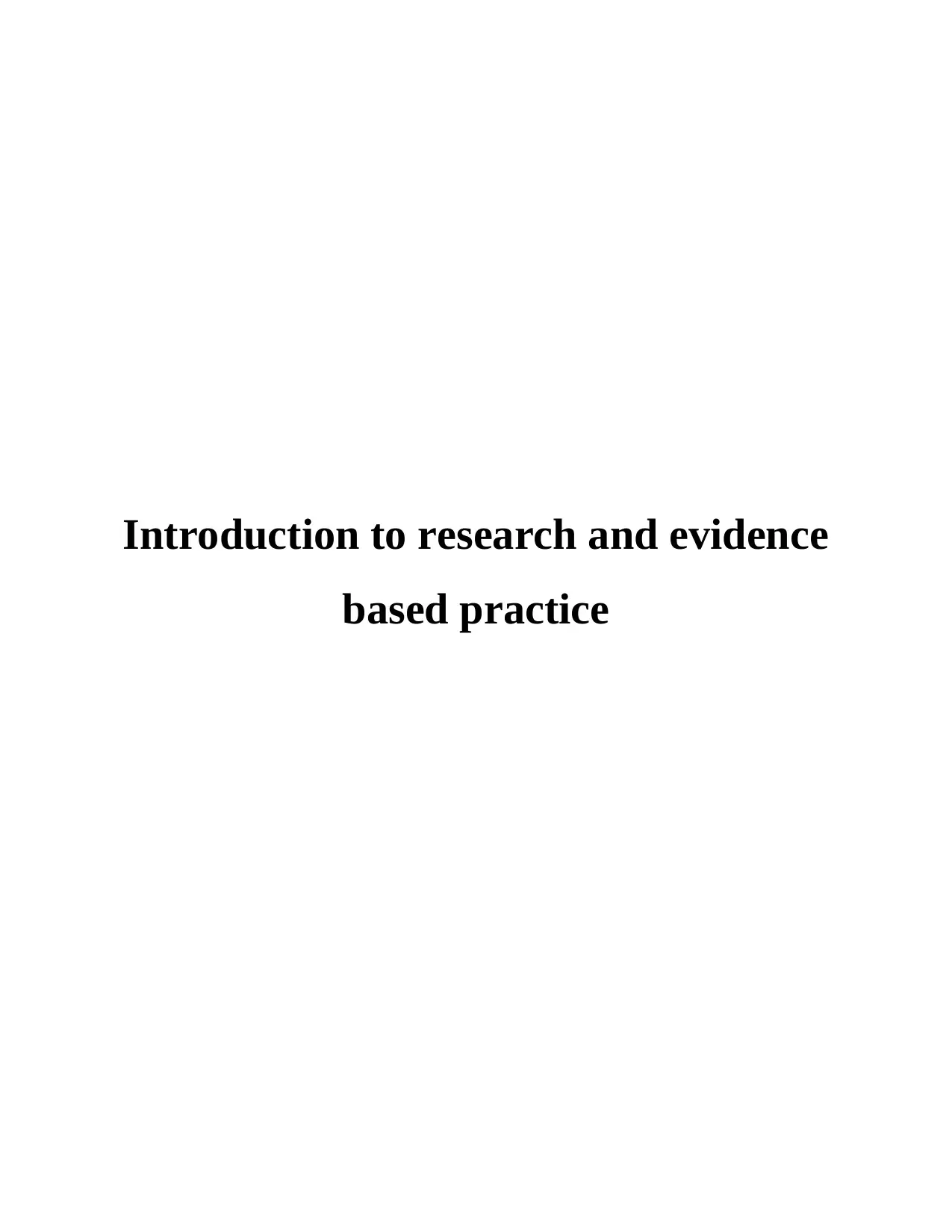
Introduction to research and evidence
based practice
based practice
Paraphrase This Document
Need a fresh take? Get an instant paraphrase of this document with our AI Paraphraser
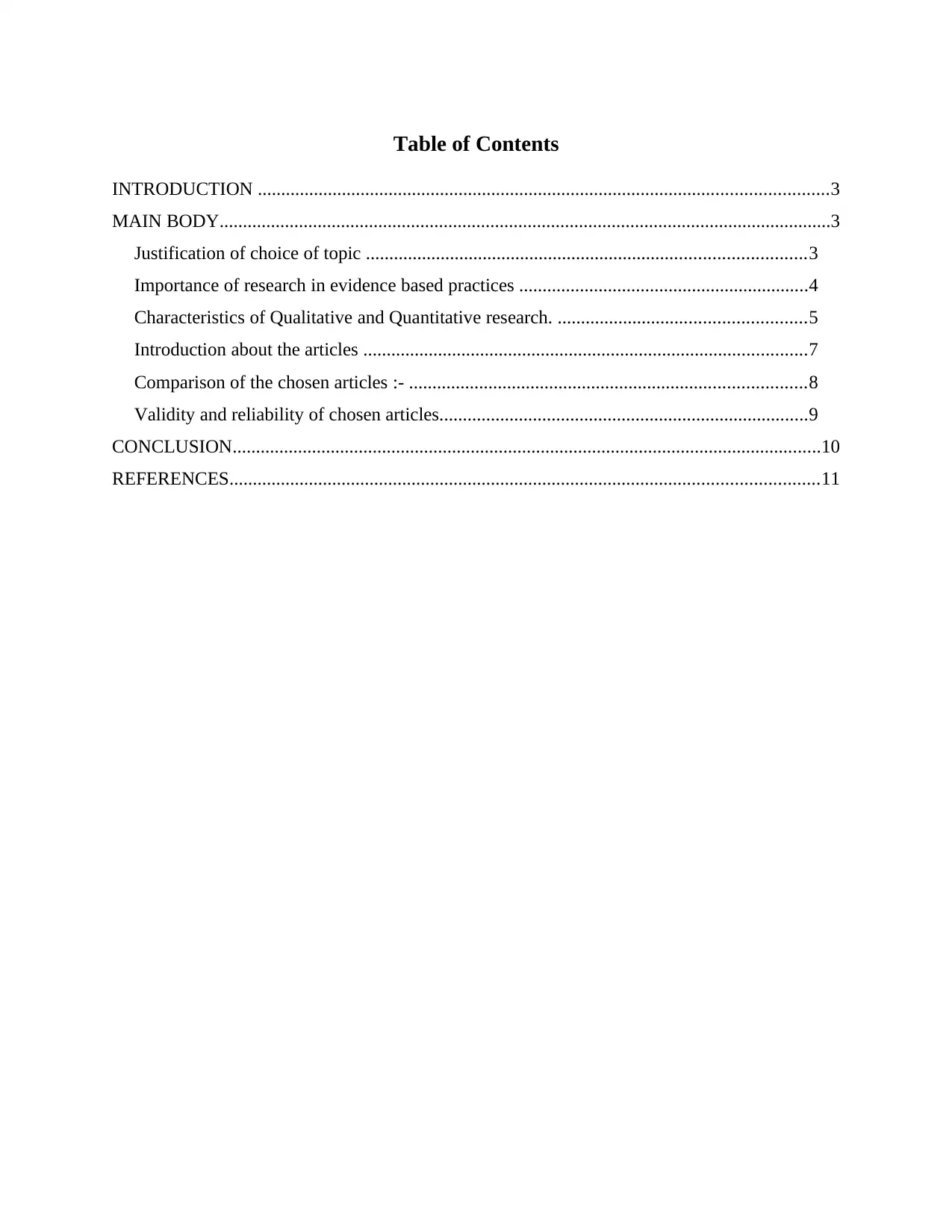
Table of Contents
INTRODUCTION ..........................................................................................................................3
MAIN BODY...................................................................................................................................3
Justification of choice of topic ..............................................................................................3
Importance of research in evidence based practices ..............................................................4
Characteristics of Qualitative and Quantitative research. .....................................................5
Introduction about the articles ...............................................................................................7
Comparison of the chosen articles :- .....................................................................................8
Validity and reliability of chosen articles...............................................................................9
CONCLUSION..............................................................................................................................10
REFERENCES..............................................................................................................................11
INTRODUCTION ..........................................................................................................................3
MAIN BODY...................................................................................................................................3
Justification of choice of topic ..............................................................................................3
Importance of research in evidence based practices ..............................................................4
Characteristics of Qualitative and Quantitative research. .....................................................5
Introduction about the articles ...............................................................................................7
Comparison of the chosen articles :- .....................................................................................8
Validity and reliability of chosen articles...............................................................................9
CONCLUSION..............................................................................................................................10
REFERENCES..............................................................................................................................11
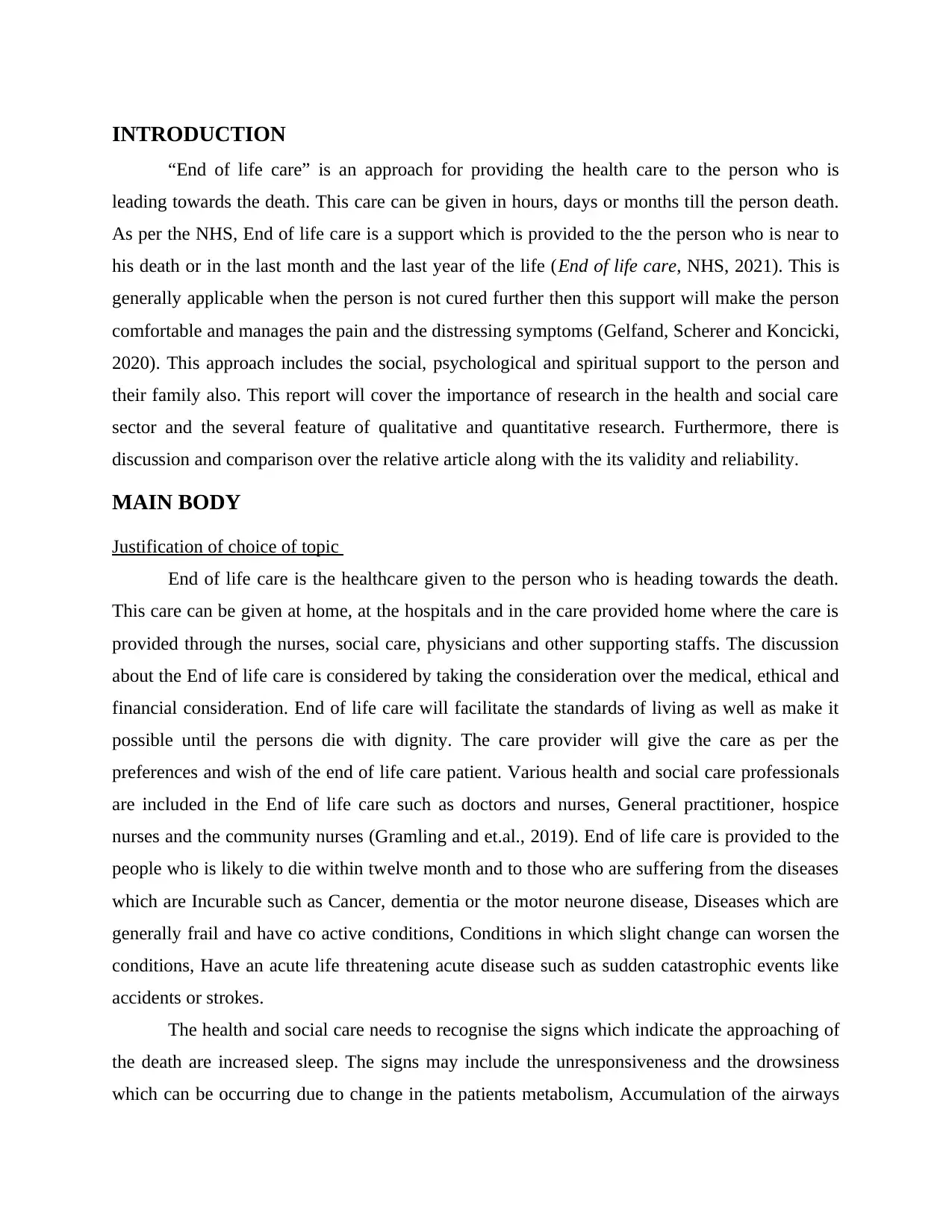
INTRODUCTION
“End of life care” is an approach for providing the health care to the person who is
leading towards the death. This care can be given in hours, days or months till the person death.
As per the NHS, End of life care is a support which is provided to the the person who is near to
his death or in the last month and the last year of the life (End of life care, NHS, 2021). This is
generally applicable when the person is not cured further then this support will make the person
comfortable and manages the pain and the distressing symptoms (Gelfand, Scherer and Koncicki,
2020). This approach includes the social, psychological and spiritual support to the person and
their family also. This report will cover the importance of research in the health and social care
sector and the several feature of qualitative and quantitative research. Furthermore, there is
discussion and comparison over the relative article along with the its validity and reliability.
MAIN BODY
Justification of choice of topic
End of life care is the healthcare given to the person who is heading towards the death.
This care can be given at home, at the hospitals and in the care provided home where the care is
provided through the nurses, social care, physicians and other supporting staffs. The discussion
about the End of life care is considered by taking the consideration over the medical, ethical and
financial consideration. End of life care will facilitate the standards of living as well as make it
possible until the persons die with dignity. The care provider will give the care as per the
preferences and wish of the end of life care patient. Various health and social care professionals
are included in the End of life care such as doctors and nurses, General practitioner, hospice
nurses and the community nurses (Gramling and et.al., 2019). End of life care is provided to the
people who is likely to die within twelve month and to those who are suffering from the diseases
which are Incurable such as Cancer, dementia or the motor neurone disease, Diseases which are
generally frail and have co active conditions, Conditions in which slight change can worsen the
conditions, Have an acute life threatening acute disease such as sudden catastrophic events like
accidents or strokes.
The health and social care needs to recognise the signs which indicate the approaching of
the death are increased sleep. The signs may include the unresponsiveness and the drowsiness
which can be occurring due to change in the patients metabolism, Accumulation of the airways
“End of life care” is an approach for providing the health care to the person who is
leading towards the death. This care can be given in hours, days or months till the person death.
As per the NHS, End of life care is a support which is provided to the the person who is near to
his death or in the last month and the last year of the life (End of life care, NHS, 2021). This is
generally applicable when the person is not cured further then this support will make the person
comfortable and manages the pain and the distressing symptoms (Gelfand, Scherer and Koncicki,
2020). This approach includes the social, psychological and spiritual support to the person and
their family also. This report will cover the importance of research in the health and social care
sector and the several feature of qualitative and quantitative research. Furthermore, there is
discussion and comparison over the relative article along with the its validity and reliability.
MAIN BODY
Justification of choice of topic
End of life care is the healthcare given to the person who is heading towards the death.
This care can be given at home, at the hospitals and in the care provided home where the care is
provided through the nurses, social care, physicians and other supporting staffs. The discussion
about the End of life care is considered by taking the consideration over the medical, ethical and
financial consideration. End of life care will facilitate the standards of living as well as make it
possible until the persons die with dignity. The care provider will give the care as per the
preferences and wish of the end of life care patient. Various health and social care professionals
are included in the End of life care such as doctors and nurses, General practitioner, hospice
nurses and the community nurses (Gramling and et.al., 2019). End of life care is provided to the
people who is likely to die within twelve month and to those who are suffering from the diseases
which are Incurable such as Cancer, dementia or the motor neurone disease, Diseases which are
generally frail and have co active conditions, Conditions in which slight change can worsen the
conditions, Have an acute life threatening acute disease such as sudden catastrophic events like
accidents or strokes.
The health and social care needs to recognise the signs which indicate the approaching of
the death are increased sleep. The signs may include the unresponsiveness and the drowsiness
which can be occurring due to change in the patients metabolism, Accumulation of the airways
⊘ This is a preview!⊘
Do you want full access?
Subscribe today to unlock all pages.

Trusted by 1+ million students worldwide
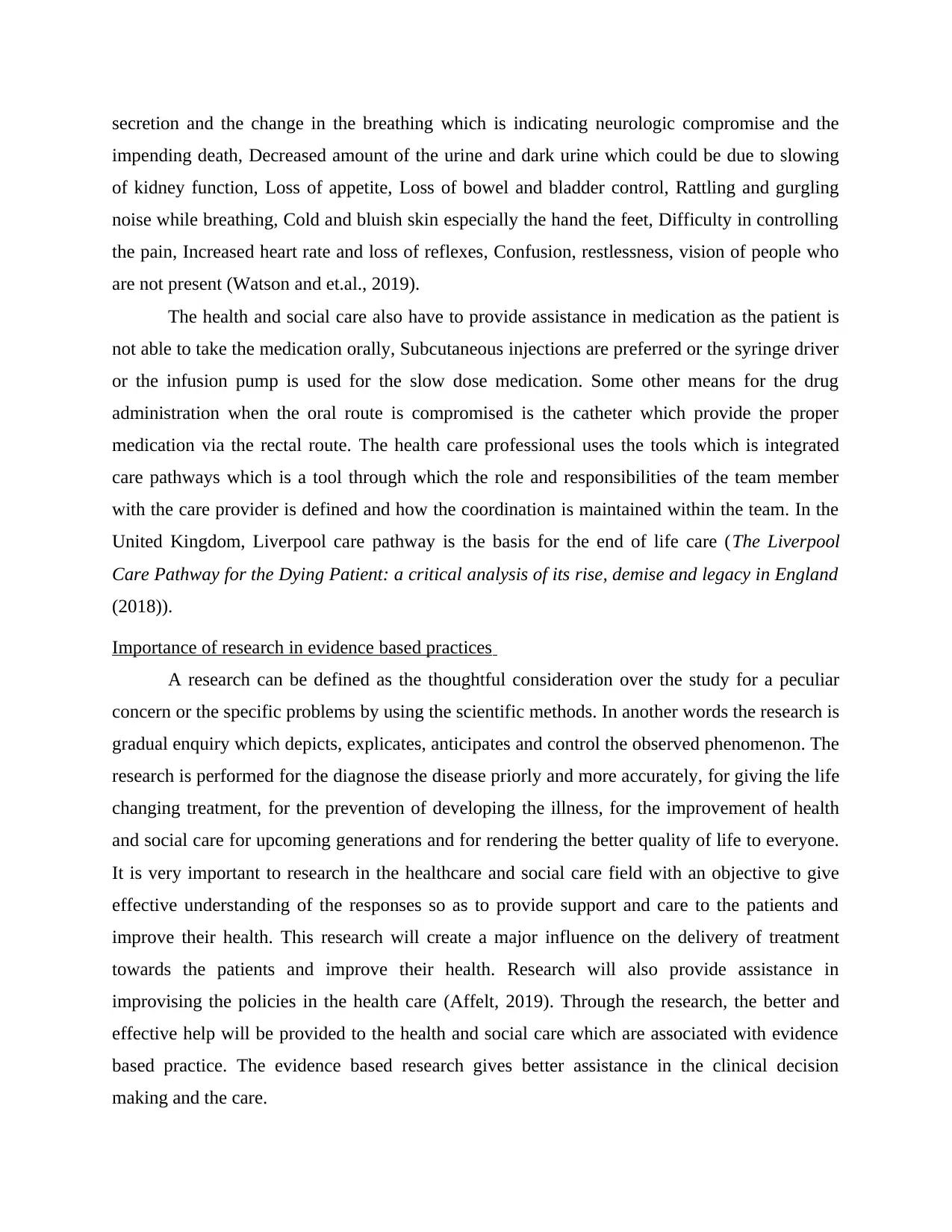
secretion and the change in the breathing which is indicating neurologic compromise and the
impending death, Decreased amount of the urine and dark urine which could be due to slowing
of kidney function, Loss of appetite, Loss of bowel and bladder control, Rattling and gurgling
noise while breathing, Cold and bluish skin especially the hand the feet, Difficulty in controlling
the pain, Increased heart rate and loss of reflexes, Confusion, restlessness, vision of people who
are not present (Watson and et.al., 2019).
The health and social care also have to provide assistance in medication as the patient is
not able to take the medication orally, Subcutaneous injections are preferred or the syringe driver
or the infusion pump is used for the slow dose medication. Some other means for the drug
administration when the oral route is compromised is the catheter which provide the proper
medication via the rectal route. The health care professional uses the tools which is integrated
care pathways which is a tool through which the role and responsibilities of the team member
with the care provider is defined and how the coordination is maintained within the team. In the
United Kingdom, Liverpool care pathway is the basis for the end of life care (The Liverpool
Care Pathway for the Dying Patient: a critical analysis of its rise, demise and legacy in England
(2018)).
Importance of research in evidence based practices
A research can be defined as the thoughtful consideration over the study for a peculiar
concern or the specific problems by using the scientific methods. In another words the research is
gradual enquiry which depicts, explicates, anticipates and control the observed phenomenon. The
research is performed for the diagnose the disease priorly and more accurately, for giving the life
changing treatment, for the prevention of developing the illness, for the improvement of health
and social care for upcoming generations and for rendering the better quality of life to everyone.
It is very important to research in the healthcare and social care field with an objective to give
effective understanding of the responses so as to provide support and care to the patients and
improve their health. This research will create a major influence on the delivery of treatment
towards the patients and improve their health. Research will also provide assistance in
improvising the policies in the health care (Affelt, 2019). Through the research, the better and
effective help will be provided to the health and social care which are associated with evidence
based practice. The evidence based research gives better assistance in the clinical decision
making and the care.
impending death, Decreased amount of the urine and dark urine which could be due to slowing
of kidney function, Loss of appetite, Loss of bowel and bladder control, Rattling and gurgling
noise while breathing, Cold and bluish skin especially the hand the feet, Difficulty in controlling
the pain, Increased heart rate and loss of reflexes, Confusion, restlessness, vision of people who
are not present (Watson and et.al., 2019).
The health and social care also have to provide assistance in medication as the patient is
not able to take the medication orally, Subcutaneous injections are preferred or the syringe driver
or the infusion pump is used for the slow dose medication. Some other means for the drug
administration when the oral route is compromised is the catheter which provide the proper
medication via the rectal route. The health care professional uses the tools which is integrated
care pathways which is a tool through which the role and responsibilities of the team member
with the care provider is defined and how the coordination is maintained within the team. In the
United Kingdom, Liverpool care pathway is the basis for the end of life care (The Liverpool
Care Pathway for the Dying Patient: a critical analysis of its rise, demise and legacy in England
(2018)).
Importance of research in evidence based practices
A research can be defined as the thoughtful consideration over the study for a peculiar
concern or the specific problems by using the scientific methods. In another words the research is
gradual enquiry which depicts, explicates, anticipates and control the observed phenomenon. The
research is performed for the diagnose the disease priorly and more accurately, for giving the life
changing treatment, for the prevention of developing the illness, for the improvement of health
and social care for upcoming generations and for rendering the better quality of life to everyone.
It is very important to research in the healthcare and social care field with an objective to give
effective understanding of the responses so as to provide support and care to the patients and
improve their health. This research will create a major influence on the delivery of treatment
towards the patients and improve their health. Research will also provide assistance in
improvising the policies in the health care (Affelt, 2019). Through the research, the better and
effective help will be provided to the health and social care which are associated with evidence
based practice. The evidence based research gives better assistance in the clinical decision
making and the care.
Paraphrase This Document
Need a fresh take? Get an instant paraphrase of this document with our AI Paraphraser
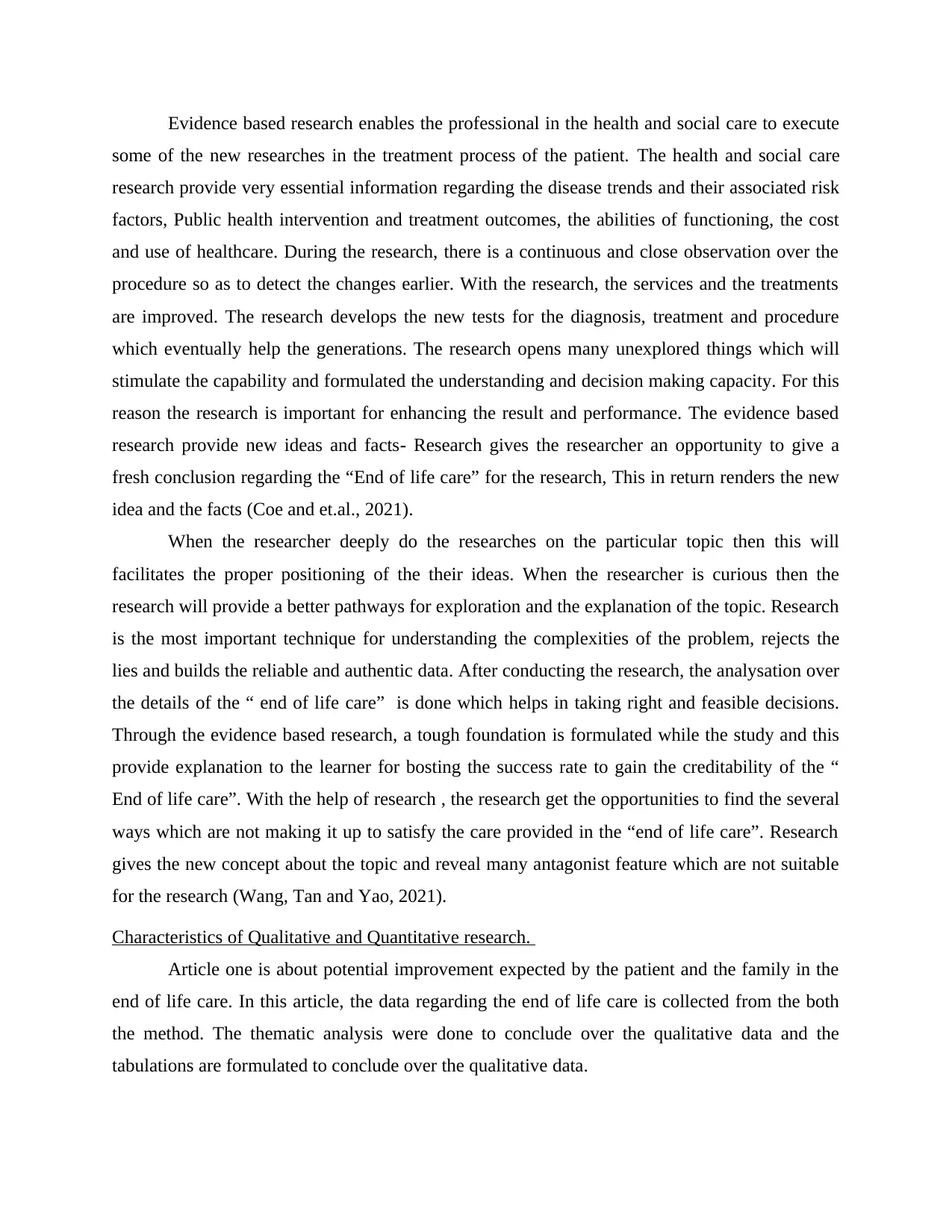
Evidence based research enables the professional in the health and social care to execute
some of the new researches in the treatment process of the patient. The health and social care
research provide very essential information regarding the disease trends and their associated risk
factors, Public health intervention and treatment outcomes, the abilities of functioning, the cost
and use of healthcare. During the research, there is a continuous and close observation over the
procedure so as to detect the changes earlier. With the research, the services and the treatments
are improved. The research develops the new tests for the diagnosis, treatment and procedure
which eventually help the generations. The research opens many unexplored things which will
stimulate the capability and formulated the understanding and decision making capacity. For this
reason the research is important for enhancing the result and performance. The evidence based
research provide new ideas and facts- Research gives the researcher an opportunity to give a
fresh conclusion regarding the “End of life care” for the research, This in return renders the new
idea and the facts (Coe and et.al., 2021).
When the researcher deeply do the researches on the particular topic then this will
facilitates the proper positioning of the their ideas. When the researcher is curious then the
research will provide a better pathways for exploration and the explanation of the topic. Research
is the most important technique for understanding the complexities of the problem, rejects the
lies and builds the reliable and authentic data. After conducting the research, the analysation over
the details of the “ end of life care” is done which helps in taking right and feasible decisions.
Through the evidence based research, a tough foundation is formulated while the study and this
provide explanation to the learner for bosting the success rate to gain the creditability of the “
End of life care”. With the help of research , the research get the opportunities to find the several
ways which are not making it up to satisfy the care provided in the “end of life care”. Research
gives the new concept about the topic and reveal many antagonist feature which are not suitable
for the research (Wang, Tan and Yao, 2021).
Characteristics of Qualitative and Quantitative research.
Article one is about potential improvement expected by the patient and the family in the
end of life care. In this article, the data regarding the end of life care is collected from the both
the method. The thematic analysis were done to conclude over the qualitative data and the
tabulations are formulated to conclude over the qualitative data.
some of the new researches in the treatment process of the patient. The health and social care
research provide very essential information regarding the disease trends and their associated risk
factors, Public health intervention and treatment outcomes, the abilities of functioning, the cost
and use of healthcare. During the research, there is a continuous and close observation over the
procedure so as to detect the changes earlier. With the research, the services and the treatments
are improved. The research develops the new tests for the diagnosis, treatment and procedure
which eventually help the generations. The research opens many unexplored things which will
stimulate the capability and formulated the understanding and decision making capacity. For this
reason the research is important for enhancing the result and performance. The evidence based
research provide new ideas and facts- Research gives the researcher an opportunity to give a
fresh conclusion regarding the “End of life care” for the research, This in return renders the new
idea and the facts (Coe and et.al., 2021).
When the researcher deeply do the researches on the particular topic then this will
facilitates the proper positioning of the their ideas. When the researcher is curious then the
research will provide a better pathways for exploration and the explanation of the topic. Research
is the most important technique for understanding the complexities of the problem, rejects the
lies and builds the reliable and authentic data. After conducting the research, the analysation over
the details of the “ end of life care” is done which helps in taking right and feasible decisions.
Through the evidence based research, a tough foundation is formulated while the study and this
provide explanation to the learner for bosting the success rate to gain the creditability of the “
End of life care”. With the help of research , the research get the opportunities to find the several
ways which are not making it up to satisfy the care provided in the “end of life care”. Research
gives the new concept about the topic and reveal many antagonist feature which are not suitable
for the research (Wang, Tan and Yao, 2021).
Characteristics of Qualitative and Quantitative research.
Article one is about potential improvement expected by the patient and the family in the
end of life care. In this article, the data regarding the end of life care is collected from the both
the method. The thematic analysis were done to conclude over the qualitative data and the
tabulations are formulated to conclude over the qualitative data.
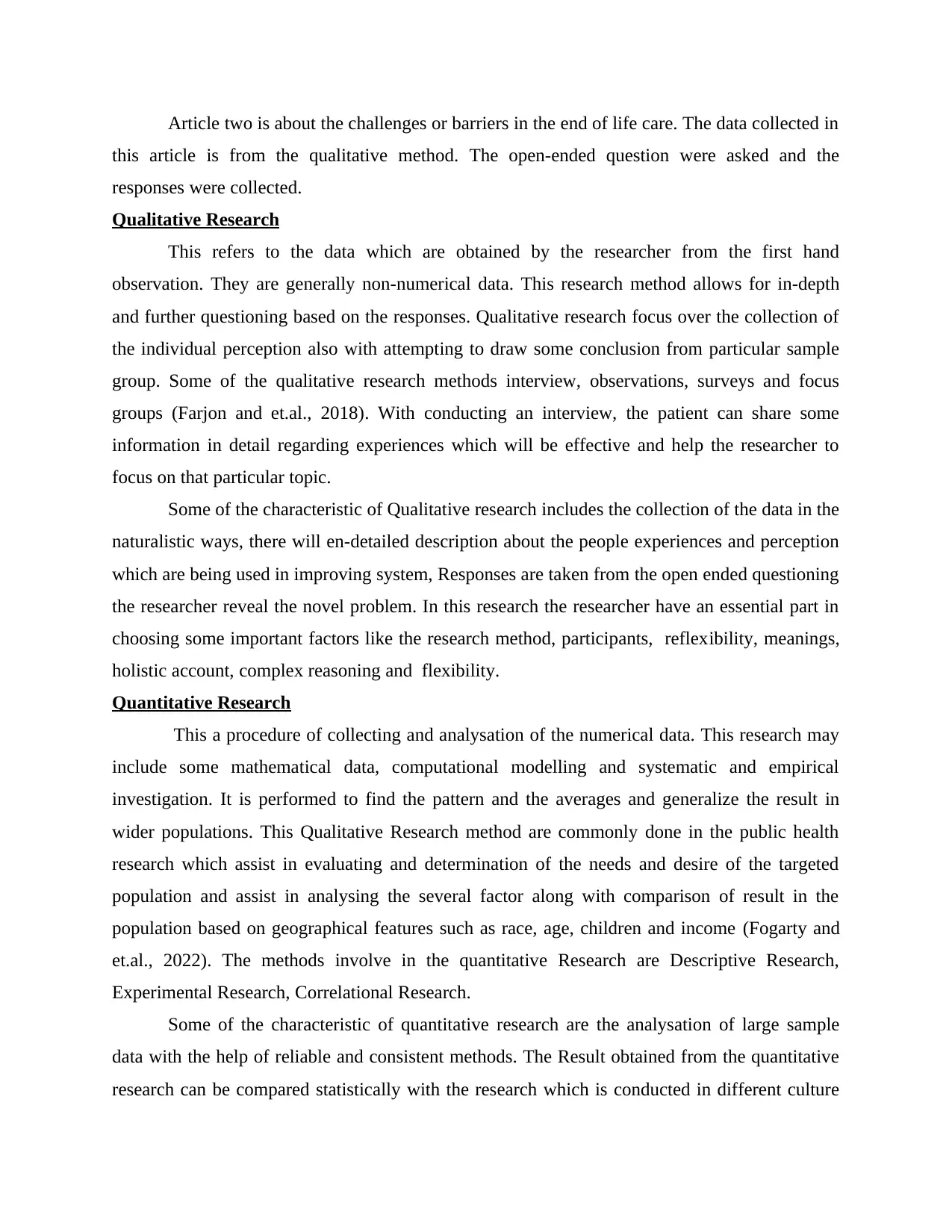
Article two is about the challenges or barriers in the end of life care. The data collected in
this article is from the qualitative method. The open-ended question were asked and the
responses were collected.
Qualitative Research
This refers to the data which are obtained by the researcher from the first hand
observation. They are generally non-numerical data. This research method allows for in-depth
and further questioning based on the responses. Qualitative research focus over the collection of
the individual perception also with attempting to draw some conclusion from particular sample
group. Some of the qualitative research methods interview, observations, surveys and focus
groups (Farjon and et.al., 2018). With conducting an interview, the patient can share some
information in detail regarding experiences which will be effective and help the researcher to
focus on that particular topic.
Some of the characteristic of Qualitative research includes the collection of the data in the
naturalistic ways, there will en-detailed description about the people experiences and perception
which are being used in improving system, Responses are taken from the open ended questioning
the researcher reveal the novel problem. In this research the researcher have an essential part in
choosing some important factors like the research method, participants, reflexibility, meanings,
holistic account, complex reasoning and flexibility.
Quantitative Research
This a procedure of collecting and analysation of the numerical data. This research may
include some mathematical data, computational modelling and systematic and empirical
investigation. It is performed to find the pattern and the averages and generalize the result in
wider populations. This Qualitative Research method are commonly done in the public health
research which assist in evaluating and determination of the needs and desire of the targeted
population and assist in analysing the several factor along with comparison of result in the
population based on geographical features such as race, age, children and income (Fogarty and
et.al., 2022). The methods involve in the quantitative Research are Descriptive Research,
Experimental Research, Correlational Research.
Some of the characteristic of quantitative research are the analysation of large sample
data with the help of reliable and consistent methods. The Result obtained from the quantitative
research can be compared statistically with the research which is conducted in different culture
this article is from the qualitative method. The open-ended question were asked and the
responses were collected.
Qualitative Research
This refers to the data which are obtained by the researcher from the first hand
observation. They are generally non-numerical data. This research method allows for in-depth
and further questioning based on the responses. Qualitative research focus over the collection of
the individual perception also with attempting to draw some conclusion from particular sample
group. Some of the qualitative research methods interview, observations, surveys and focus
groups (Farjon and et.al., 2018). With conducting an interview, the patient can share some
information in detail regarding experiences which will be effective and help the researcher to
focus on that particular topic.
Some of the characteristic of Qualitative research includes the collection of the data in the
naturalistic ways, there will en-detailed description about the people experiences and perception
which are being used in improving system, Responses are taken from the open ended questioning
the researcher reveal the novel problem. In this research the researcher have an essential part in
choosing some important factors like the research method, participants, reflexibility, meanings,
holistic account, complex reasoning and flexibility.
Quantitative Research
This a procedure of collecting and analysation of the numerical data. This research may
include some mathematical data, computational modelling and systematic and empirical
investigation. It is performed to find the pattern and the averages and generalize the result in
wider populations. This Qualitative Research method are commonly done in the public health
research which assist in evaluating and determination of the needs and desire of the targeted
population and assist in analysing the several factor along with comparison of result in the
population based on geographical features such as race, age, children and income (Fogarty and
et.al., 2022). The methods involve in the quantitative Research are Descriptive Research,
Experimental Research, Correlational Research.
Some of the characteristic of quantitative research are the analysation of large sample
data with the help of reliable and consistent methods. The Result obtained from the quantitative
research can be compared statistically with the research which is conducted in different culture
⊘ This is a preview!⊘
Do you want full access?
Subscribe today to unlock all pages.

Trusted by 1+ million students worldwide
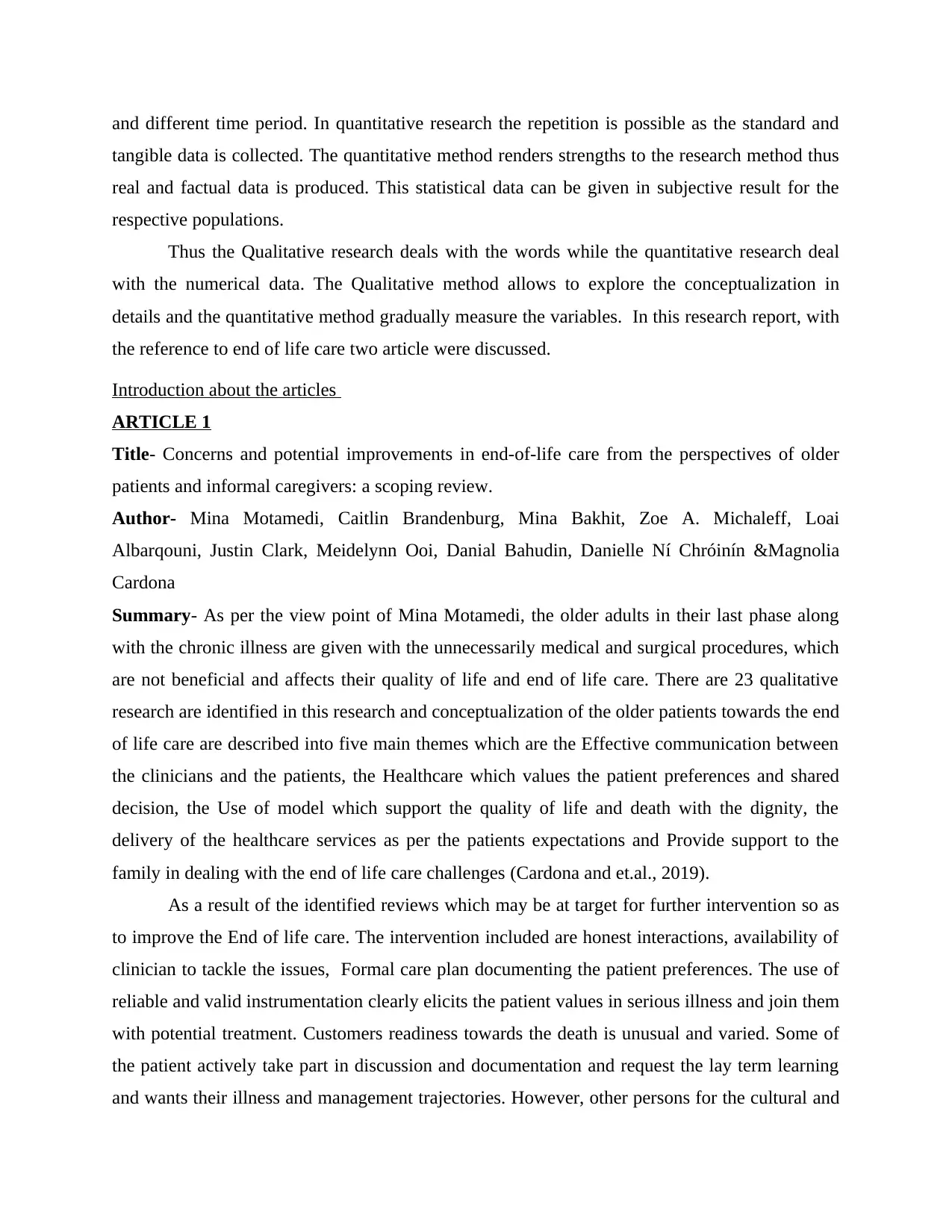
and different time period. In quantitative research the repetition is possible as the standard and
tangible data is collected. The quantitative method renders strengths to the research method thus
real and factual data is produced. This statistical data can be given in subjective result for the
respective populations.
Thus the Qualitative research deals with the words while the quantitative research deal
with the numerical data. The Qualitative method allows to explore the conceptualization in
details and the quantitative method gradually measure the variables. In this research report, with
the reference to end of life care two article were discussed.
Introduction about the articles
ARTICLE 1
Title- Concerns and potential improvements in end-of-life care from the perspectives of older
patients and informal caregivers: a scoping review.
Author- Mina Motamedi, Caitlin Brandenburg, Mina Bakhit, Zoe A. Michaleff, Loai
Albarqouni, Justin Clark, Meidelynn Ooi, Danial Bahudin, Danielle Ní Chróinín &Magnolia
Cardona
Summary- As per the view point of Mina Motamedi, the older adults in their last phase along
with the chronic illness are given with the unnecessarily medical and surgical procedures, which
are not beneficial and affects their quality of life and end of life care. There are 23 qualitative
research are identified in this research and conceptualization of the older patients towards the end
of life care are described into five main themes which are the Effective communication between
the clinicians and the patients, the Healthcare which values the patient preferences and shared
decision, the Use of model which support the quality of life and death with the dignity, the
delivery of the healthcare services as per the patients expectations and Provide support to the
family in dealing with the end of life care challenges (Cardona and et.al., 2019).
As a result of the identified reviews which may be at target for further intervention so as
to improve the End of life care. The intervention included are honest interactions, availability of
clinician to tackle the issues, Formal care plan documenting the patient preferences. The use of
reliable and valid instrumentation clearly elicits the patient values in serious illness and join them
with potential treatment. Customers readiness towards the death is unusual and varied. Some of
the patient actively take part in discussion and documentation and request the lay term learning
and wants their illness and management trajectories. However, other persons for the cultural and
tangible data is collected. The quantitative method renders strengths to the research method thus
real and factual data is produced. This statistical data can be given in subjective result for the
respective populations.
Thus the Qualitative research deals with the words while the quantitative research deal
with the numerical data. The Qualitative method allows to explore the conceptualization in
details and the quantitative method gradually measure the variables. In this research report, with
the reference to end of life care two article were discussed.
Introduction about the articles
ARTICLE 1
Title- Concerns and potential improvements in end-of-life care from the perspectives of older
patients and informal caregivers: a scoping review.
Author- Mina Motamedi, Caitlin Brandenburg, Mina Bakhit, Zoe A. Michaleff, Loai
Albarqouni, Justin Clark, Meidelynn Ooi, Danial Bahudin, Danielle Ní Chróinín &Magnolia
Cardona
Summary- As per the view point of Mina Motamedi, the older adults in their last phase along
with the chronic illness are given with the unnecessarily medical and surgical procedures, which
are not beneficial and affects their quality of life and end of life care. There are 23 qualitative
research are identified in this research and conceptualization of the older patients towards the end
of life care are described into five main themes which are the Effective communication between
the clinicians and the patients, the Healthcare which values the patient preferences and shared
decision, the Use of model which support the quality of life and death with the dignity, the
delivery of the healthcare services as per the patients expectations and Provide support to the
family in dealing with the end of life care challenges (Cardona and et.al., 2019).
As a result of the identified reviews which may be at target for further intervention so as
to improve the End of life care. The intervention included are honest interactions, availability of
clinician to tackle the issues, Formal care plan documenting the patient preferences. The use of
reliable and valid instrumentation clearly elicits the patient values in serious illness and join them
with potential treatment. Customers readiness towards the death is unusual and varied. Some of
the patient actively take part in discussion and documentation and request the lay term learning
and wants their illness and management trajectories. However, other persons for the cultural and
Paraphrase This Document
Need a fresh take? Get an instant paraphrase of this document with our AI Paraphraser
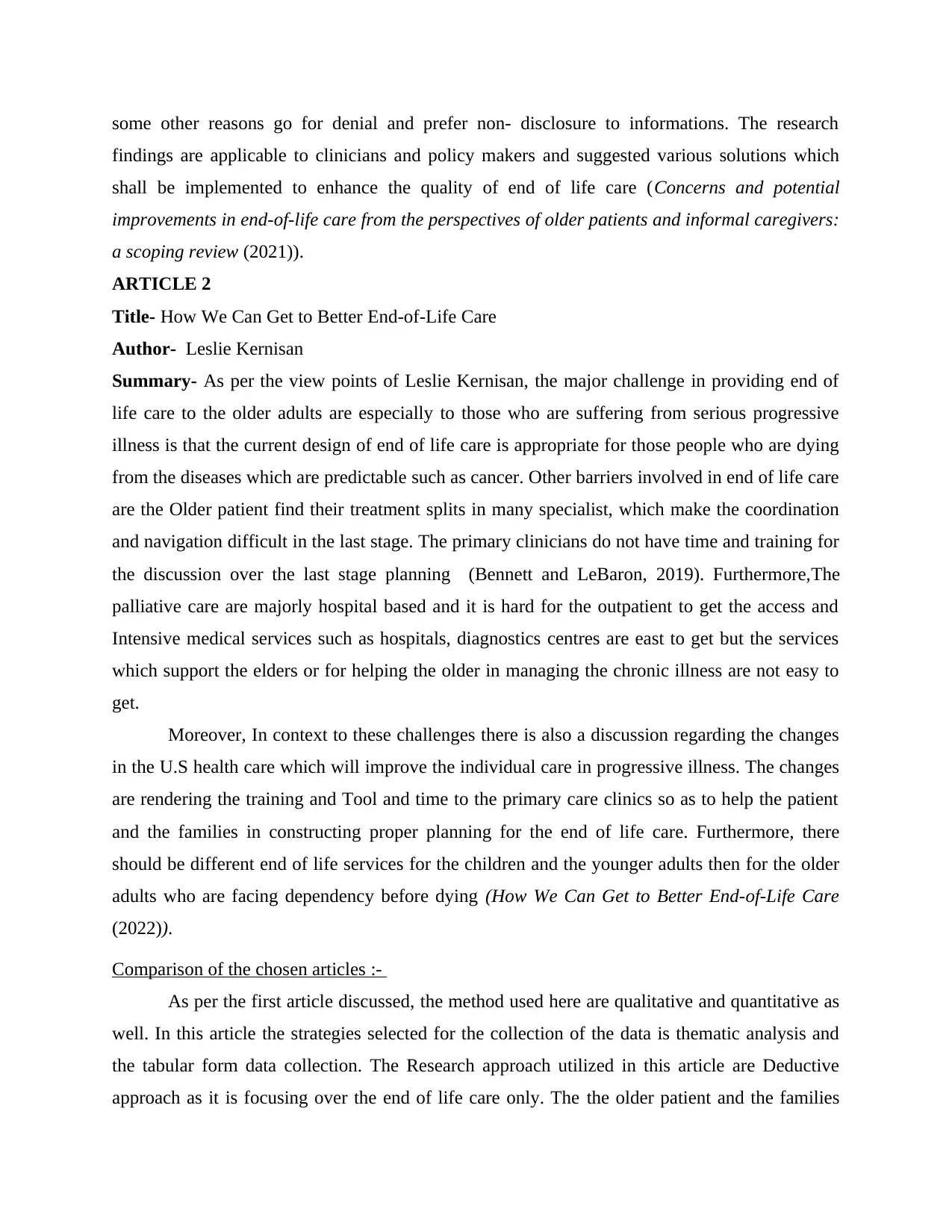
some other reasons go for denial and prefer non- disclosure to informations. The research
findings are applicable to clinicians and policy makers and suggested various solutions which
shall be implemented to enhance the quality of end of life care (Concerns and potential
improvements in end-of-life care from the perspectives of older patients and informal caregivers:
a scoping review (2021)).
ARTICLE 2
Title- How We Can Get to Better End-of-Life Care
Author- Leslie Kernisan
Summary- As per the view points of Leslie Kernisan, the major challenge in providing end of
life care to the older adults are especially to those who are suffering from serious progressive
illness is that the current design of end of life care is appropriate for those people who are dying
from the diseases which are predictable such as cancer. Other barriers involved in end of life care
are the Older patient find their treatment splits in many specialist, which make the coordination
and navigation difficult in the last stage. The primary clinicians do not have time and training for
the discussion over the last stage planning (Bennett and LeBaron, 2019). Furthermore,The
palliative care are majorly hospital based and it is hard for the outpatient to get the access and
Intensive medical services such as hospitals, diagnostics centres are east to get but the services
which support the elders or for helping the older in managing the chronic illness are not easy to
get.
Moreover, In context to these challenges there is also a discussion regarding the changes
in the U.S health care which will improve the individual care in progressive illness. The changes
are rendering the training and Tool and time to the primary care clinics so as to help the patient
and the families in constructing proper planning for the end of life care. Furthermore, there
should be different end of life services for the children and the younger adults then for the older
adults who are facing dependency before dying (How We Can Get to Better End-of-Life Care
(2022)).
Comparison of the chosen articles :-
As per the first article discussed, the method used here are qualitative and quantitative as
well. In this article the strategies selected for the collection of the data is thematic analysis and
the tabular form data collection. The Research approach utilized in this article are Deductive
approach as it is focusing over the end of life care only. The the older patient and the families
findings are applicable to clinicians and policy makers and suggested various solutions which
shall be implemented to enhance the quality of end of life care (Concerns and potential
improvements in end-of-life care from the perspectives of older patients and informal caregivers:
a scoping review (2021)).
ARTICLE 2
Title- How We Can Get to Better End-of-Life Care
Author- Leslie Kernisan
Summary- As per the view points of Leslie Kernisan, the major challenge in providing end of
life care to the older adults are especially to those who are suffering from serious progressive
illness is that the current design of end of life care is appropriate for those people who are dying
from the diseases which are predictable such as cancer. Other barriers involved in end of life care
are the Older patient find their treatment splits in many specialist, which make the coordination
and navigation difficult in the last stage. The primary clinicians do not have time and training for
the discussion over the last stage planning (Bennett and LeBaron, 2019). Furthermore,The
palliative care are majorly hospital based and it is hard for the outpatient to get the access and
Intensive medical services such as hospitals, diagnostics centres are east to get but the services
which support the elders or for helping the older in managing the chronic illness are not easy to
get.
Moreover, In context to these challenges there is also a discussion regarding the changes
in the U.S health care which will improve the individual care in progressive illness. The changes
are rendering the training and Tool and time to the primary care clinics so as to help the patient
and the families in constructing proper planning for the end of life care. Furthermore, there
should be different end of life services for the children and the younger adults then for the older
adults who are facing dependency before dying (How We Can Get to Better End-of-Life Care
(2022)).
Comparison of the chosen articles :-
As per the first article discussed, the method used here are qualitative and quantitative as
well. In this article the strategies selected for the collection of the data is thematic analysis and
the tabular form data collection. The Research approach utilized in this article are Deductive
approach as it is focusing over the end of life care only. The the older patient and the families
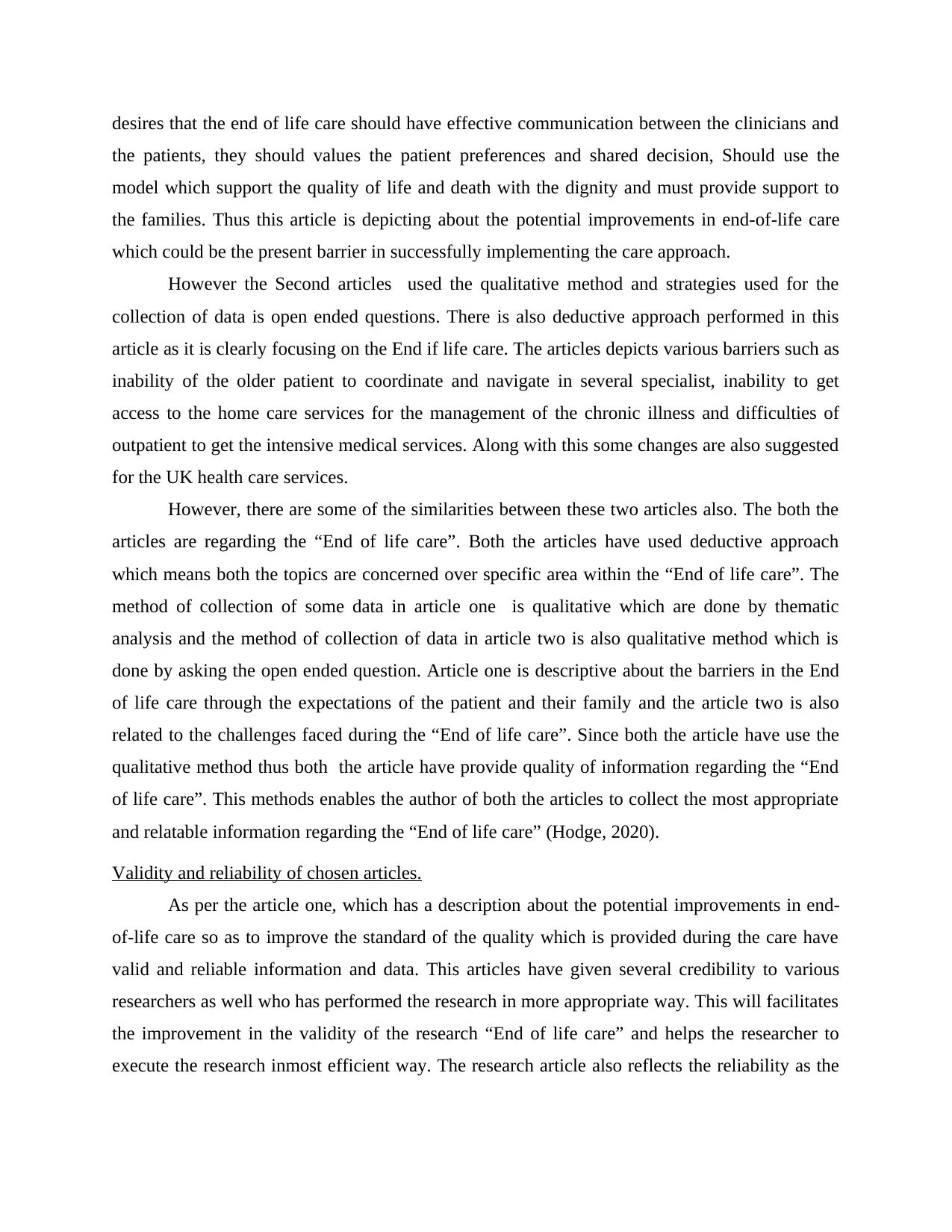
desires that the end of life care should have effective communication between the clinicians and
the patients, they should values the patient preferences and shared decision, Should use the
model which support the quality of life and death with the dignity and must provide support to
the families. Thus this article is depicting about the potential improvements in end-of-life care
which could be the present barrier in successfully implementing the care approach.
However the Second articles used the qualitative method and strategies used for the
collection of data is open ended questions. There is also deductive approach performed in this
article as it is clearly focusing on the End if life care. The articles depicts various barriers such as
inability of the older patient to coordinate and navigate in several specialist, inability to get
access to the home care services for the management of the chronic illness and difficulties of
outpatient to get the intensive medical services. Along with this some changes are also suggested
for the UK health care services.
However, there are some of the similarities between these two articles also. The both the
articles are regarding the “End of life care”. Both the articles have used deductive approach
which means both the topics are concerned over specific area within the “End of life care”. The
method of collection of some data in article one is qualitative which are done by thematic
analysis and the method of collection of data in article two is also qualitative method which is
done by asking the open ended question. Article one is descriptive about the barriers in the End
of life care through the expectations of the patient and their family and the article two is also
related to the challenges faced during the “End of life care”. Since both the article have use the
qualitative method thus both the article have provide quality of information regarding the “End
of life care”. This methods enables the author of both the articles to collect the most appropriate
and relatable information regarding the “End of life care” (Hodge, 2020).
Validity and reliability of chosen articles.
As per the article one, which has a description about the potential improvements in end-
of-life care so as to improve the standard of the quality which is provided during the care have
valid and reliable information and data. This articles have given several credibility to various
researchers as well who has performed the research in more appropriate way. This will facilitates
the improvement in the validity of the research “End of life care” and helps the researcher to
execute the research inmost efficient way. The research article also reflects the reliability as the
the patients, they should values the patient preferences and shared decision, Should use the
model which support the quality of life and death with the dignity and must provide support to
the families. Thus this article is depicting about the potential improvements in end-of-life care
which could be the present barrier in successfully implementing the care approach.
However the Second articles used the qualitative method and strategies used for the
collection of data is open ended questions. There is also deductive approach performed in this
article as it is clearly focusing on the End if life care. The articles depicts various barriers such as
inability of the older patient to coordinate and navigate in several specialist, inability to get
access to the home care services for the management of the chronic illness and difficulties of
outpatient to get the intensive medical services. Along with this some changes are also suggested
for the UK health care services.
However, there are some of the similarities between these two articles also. The both the
articles are regarding the “End of life care”. Both the articles have used deductive approach
which means both the topics are concerned over specific area within the “End of life care”. The
method of collection of some data in article one is qualitative which are done by thematic
analysis and the method of collection of data in article two is also qualitative method which is
done by asking the open ended question. Article one is descriptive about the barriers in the End
of life care through the expectations of the patient and their family and the article two is also
related to the challenges faced during the “End of life care”. Since both the article have use the
qualitative method thus both the article have provide quality of information regarding the “End
of life care”. This methods enables the author of both the articles to collect the most appropriate
and relatable information regarding the “End of life care” (Hodge, 2020).
Validity and reliability of chosen articles.
As per the article one, which has a description about the potential improvements in end-
of-life care so as to improve the standard of the quality which is provided during the care have
valid and reliable information and data. This articles have given several credibility to various
researchers as well who has performed the research in more appropriate way. This will facilitates
the improvement in the validity of the research “End of life care” and helps the researcher to
execute the research inmost efficient way. The research article also reflects the reliability as the
⊘ This is a preview!⊘
Do you want full access?
Subscribe today to unlock all pages.

Trusted by 1+ million students worldwide
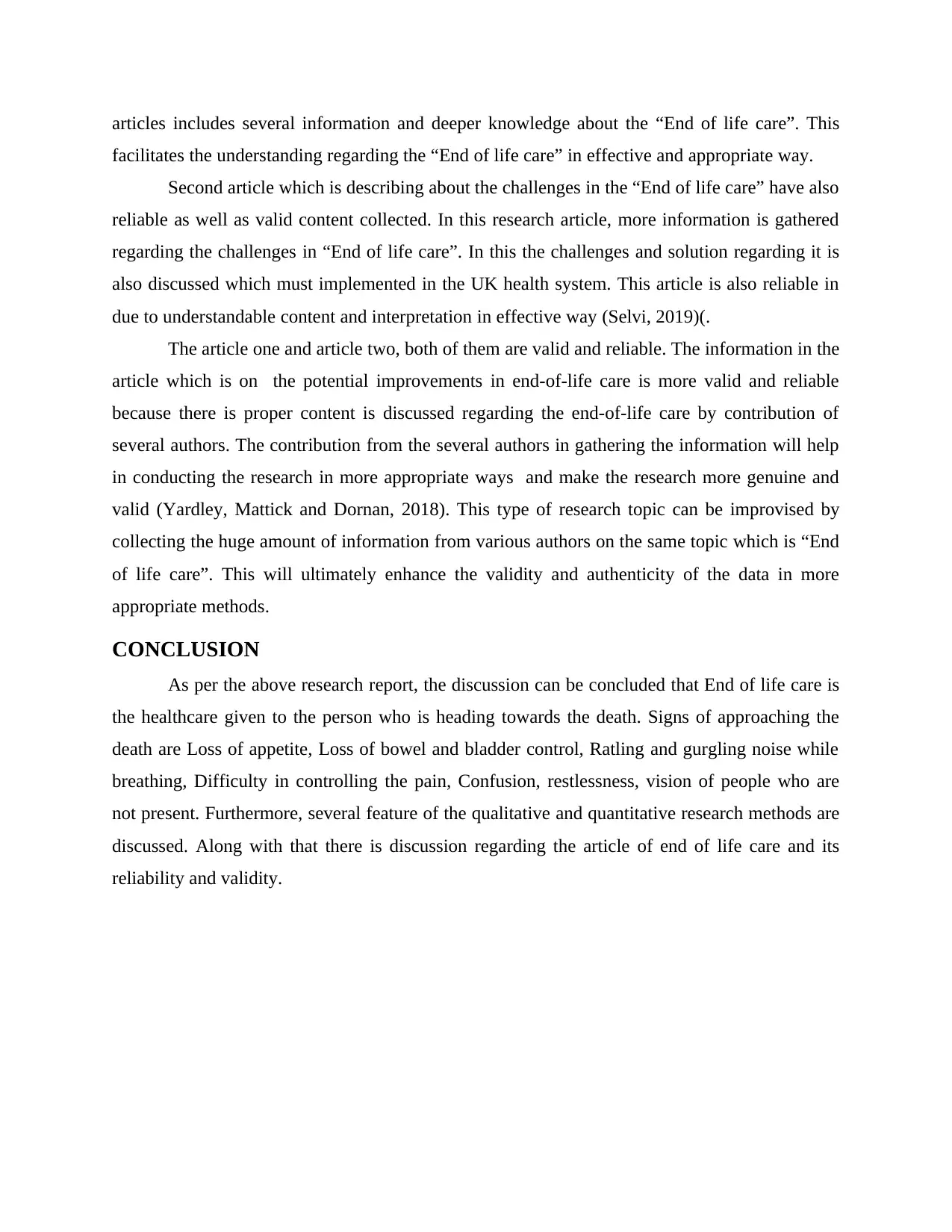
articles includes several information and deeper knowledge about the “End of life care”. This
facilitates the understanding regarding the “End of life care” in effective and appropriate way.
Second article which is describing about the challenges in the “End of life care” have also
reliable as well as valid content collected. In this research article, more information is gathered
regarding the challenges in “End of life care”. In this the challenges and solution regarding it is
also discussed which must implemented in the UK health system. This article is also reliable in
due to understandable content and interpretation in effective way (Selvi, 2019)(.
The article one and article two, both of them are valid and reliable. The information in the
article which is on the potential improvements in end-of-life care is more valid and reliable
because there is proper content is discussed regarding the end-of-life care by contribution of
several authors. The contribution from the several authors in gathering the information will help
in conducting the research in more appropriate ways and make the research more genuine and
valid (Yardley, Mattick and Dornan, 2018). This type of research topic can be improvised by
collecting the huge amount of information from various authors on the same topic which is “End
of life care”. This will ultimately enhance the validity and authenticity of the data in more
appropriate methods.
CONCLUSION
As per the above research report, the discussion can be concluded that End of life care is
the healthcare given to the person who is heading towards the death. Signs of approaching the
death are Loss of appetite, Loss of bowel and bladder control, Ratling and gurgling noise while
breathing, Difficulty in controlling the pain, Confusion, restlessness, vision of people who are
not present. Furthermore, several feature of the qualitative and quantitative research methods are
discussed. Along with that there is discussion regarding the article of end of life care and its
reliability and validity.
facilitates the understanding regarding the “End of life care” in effective and appropriate way.
Second article which is describing about the challenges in the “End of life care” have also
reliable as well as valid content collected. In this research article, more information is gathered
regarding the challenges in “End of life care”. In this the challenges and solution regarding it is
also discussed which must implemented in the UK health system. This article is also reliable in
due to understandable content and interpretation in effective way (Selvi, 2019)(.
The article one and article two, both of them are valid and reliable. The information in the
article which is on the potential improvements in end-of-life care is more valid and reliable
because there is proper content is discussed regarding the end-of-life care by contribution of
several authors. The contribution from the several authors in gathering the information will help
in conducting the research in more appropriate ways and make the research more genuine and
valid (Yardley, Mattick and Dornan, 2018). This type of research topic can be improvised by
collecting the huge amount of information from various authors on the same topic which is “End
of life care”. This will ultimately enhance the validity and authenticity of the data in more
appropriate methods.
CONCLUSION
As per the above research report, the discussion can be concluded that End of life care is
the healthcare given to the person who is heading towards the death. Signs of approaching the
death are Loss of appetite, Loss of bowel and bladder control, Ratling and gurgling noise while
breathing, Difficulty in controlling the pain, Confusion, restlessness, vision of people who are
not present. Furthermore, several feature of the qualitative and quantitative research methods are
discussed. Along with that there is discussion regarding the article of end of life care and its
reliability and validity.
Paraphrase This Document
Need a fresh take? Get an instant paraphrase of this document with our AI Paraphraser
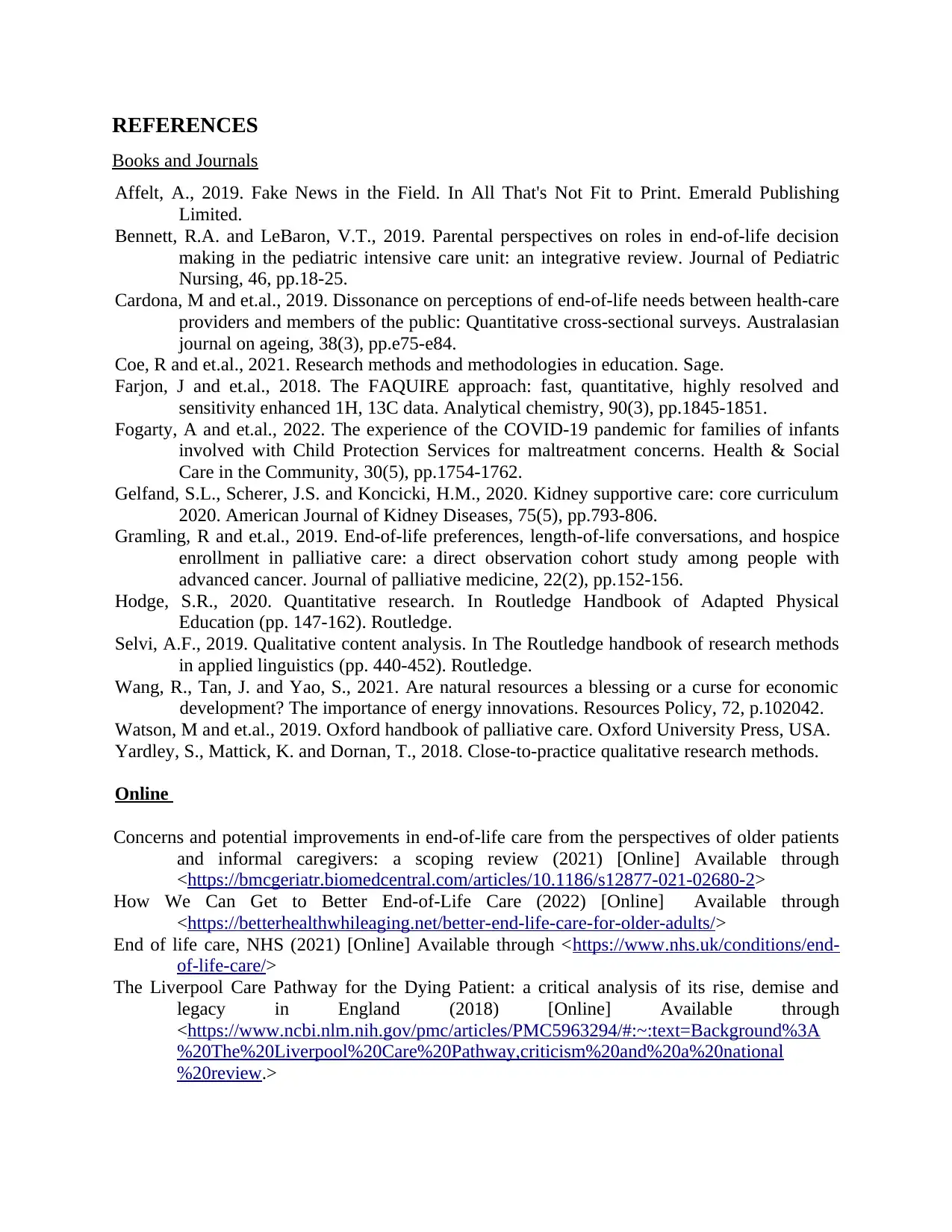
REFERENCES
Books and Journals
Affelt, A., 2019. Fake News in the Field. In All That's Not Fit to Print. Emerald Publishing
Limited.
Bennett, R.A. and LeBaron, V.T., 2019. Parental perspectives on roles in end-of-life decision
making in the pediatric intensive care unit: an integrative review. Journal of Pediatric
Nursing, 46, pp.18-25.
Cardona, M and et.al., 2019. Dissonance on perceptions of end‐of‐life needs between health‐care
providers and members of the public: Quantitative cross‐sectional surveys. Australasian
journal on ageing, 38(3), pp.e75-e84.
Coe, R and et.al., 2021. Research methods and methodologies in education. Sage.
Farjon, J and et.al., 2018. The FAQUIRE approach: fast, quantitative, highly resolved and
sensitivity enhanced 1H, 13C data. Analytical chemistry, 90(3), pp.1845-1851.
Fogarty, A and et.al., 2022. The experience of the COVID‐19 pandemic for families of infants
involved with Child Protection Services for maltreatment concerns. Health & Social
Care in the Community, 30(5), pp.1754-1762.
Gelfand, S.L., Scherer, J.S. and Koncicki, H.M., 2020. Kidney supportive care: core curriculum
2020. American Journal of Kidney Diseases, 75(5), pp.793-806.
Gramling, R and et.al., 2019. End-of-life preferences, length-of-life conversations, and hospice
enrollment in palliative care: a direct observation cohort study among people with
advanced cancer. Journal of palliative medicine, 22(2), pp.152-156.
Hodge, S.R., 2020. Quantitative research. In Routledge Handbook of Adapted Physical
Education (pp. 147-162). Routledge.
Selvi, A.F., 2019. Qualitative content analysis. In The Routledge handbook of research methods
in applied linguistics (pp. 440-452). Routledge.
Wang, R., Tan, J. and Yao, S., 2021. Are natural resources a blessing or a curse for economic
development? The importance of energy innovations. Resources Policy, 72, p.102042.
Watson, M and et.al., 2019. Oxford handbook of palliative care. Oxford University Press, USA.
Yardley, S., Mattick, K. and Dornan, T., 2018. Close-to-practice qualitative research methods.
Online
Concerns and potential improvements in end-of-life care from the perspectives of older patients
and informal caregivers: a scoping review (2021) [Online] Available through
<https://bmcgeriatr.biomedcentral.com/articles/10.1186/s12877-021-02680-2>
How We Can Get to Better End-of-Life Care (2022) [Online] Available through
<https://betterhealthwhileaging.net/better-end-life-care-for-older-adults/>
End of life care, NHS (2021) [Online] Available through <https://www.nhs.uk/conditions/end-
of-life-care/>
The Liverpool Care Pathway for the Dying Patient: a critical analysis of its rise, demise and
legacy in England (2018) [Online] Available through
<https://www.ncbi.nlm.nih.gov/pmc/articles/PMC5963294/#:~:text=Background%3A
%20The%20Liverpool%20Care%20Pathway,criticism%20and%20a%20national
%20review.>
Books and Journals
Affelt, A., 2019. Fake News in the Field. In All That's Not Fit to Print. Emerald Publishing
Limited.
Bennett, R.A. and LeBaron, V.T., 2019. Parental perspectives on roles in end-of-life decision
making in the pediatric intensive care unit: an integrative review. Journal of Pediatric
Nursing, 46, pp.18-25.
Cardona, M and et.al., 2019. Dissonance on perceptions of end‐of‐life needs between health‐care
providers and members of the public: Quantitative cross‐sectional surveys. Australasian
journal on ageing, 38(3), pp.e75-e84.
Coe, R and et.al., 2021. Research methods and methodologies in education. Sage.
Farjon, J and et.al., 2018. The FAQUIRE approach: fast, quantitative, highly resolved and
sensitivity enhanced 1H, 13C data. Analytical chemistry, 90(3), pp.1845-1851.
Fogarty, A and et.al., 2022. The experience of the COVID‐19 pandemic for families of infants
involved with Child Protection Services for maltreatment concerns. Health & Social
Care in the Community, 30(5), pp.1754-1762.
Gelfand, S.L., Scherer, J.S. and Koncicki, H.M., 2020. Kidney supportive care: core curriculum
2020. American Journal of Kidney Diseases, 75(5), pp.793-806.
Gramling, R and et.al., 2019. End-of-life preferences, length-of-life conversations, and hospice
enrollment in palliative care: a direct observation cohort study among people with
advanced cancer. Journal of palliative medicine, 22(2), pp.152-156.
Hodge, S.R., 2020. Quantitative research. In Routledge Handbook of Adapted Physical
Education (pp. 147-162). Routledge.
Selvi, A.F., 2019. Qualitative content analysis. In The Routledge handbook of research methods
in applied linguistics (pp. 440-452). Routledge.
Wang, R., Tan, J. and Yao, S., 2021. Are natural resources a blessing or a curse for economic
development? The importance of energy innovations. Resources Policy, 72, p.102042.
Watson, M and et.al., 2019. Oxford handbook of palliative care. Oxford University Press, USA.
Yardley, S., Mattick, K. and Dornan, T., 2018. Close-to-practice qualitative research methods.
Online
Concerns and potential improvements in end-of-life care from the perspectives of older patients
and informal caregivers: a scoping review (2021) [Online] Available through
<https://bmcgeriatr.biomedcentral.com/articles/10.1186/s12877-021-02680-2>
How We Can Get to Better End-of-Life Care (2022) [Online] Available through
<https://betterhealthwhileaging.net/better-end-life-care-for-older-adults/>
End of life care, NHS (2021) [Online] Available through <https://www.nhs.uk/conditions/end-
of-life-care/>
The Liverpool Care Pathway for the Dying Patient: a critical analysis of its rise, demise and
legacy in England (2018) [Online] Available through
<https://www.ncbi.nlm.nih.gov/pmc/articles/PMC5963294/#:~:text=Background%3A
%20The%20Liverpool%20Care%20Pathway,criticism%20and%20a%20national
%20review.>
1 out of 11
Related Documents
Your All-in-One AI-Powered Toolkit for Academic Success.
+13062052269
info@desklib.com
Available 24*7 on WhatsApp / Email
![[object Object]](/_next/static/media/star-bottom.7253800d.svg)
Unlock your academic potential
Copyright © 2020–2025 A2Z Services. All Rights Reserved. Developed and managed by ZUCOL.





